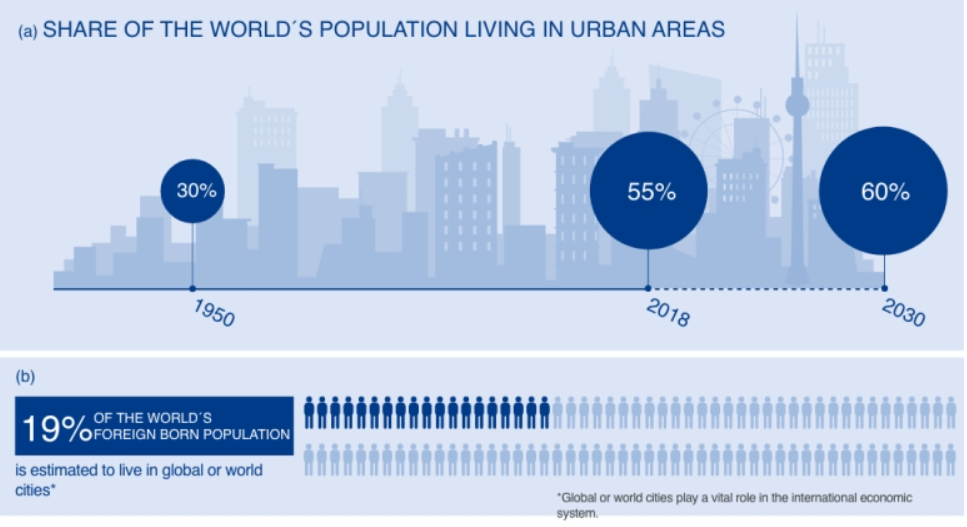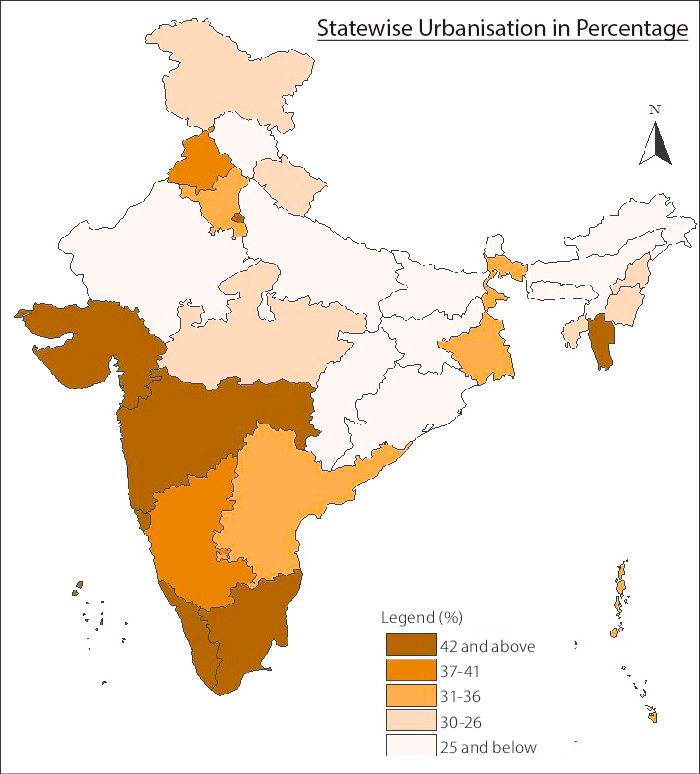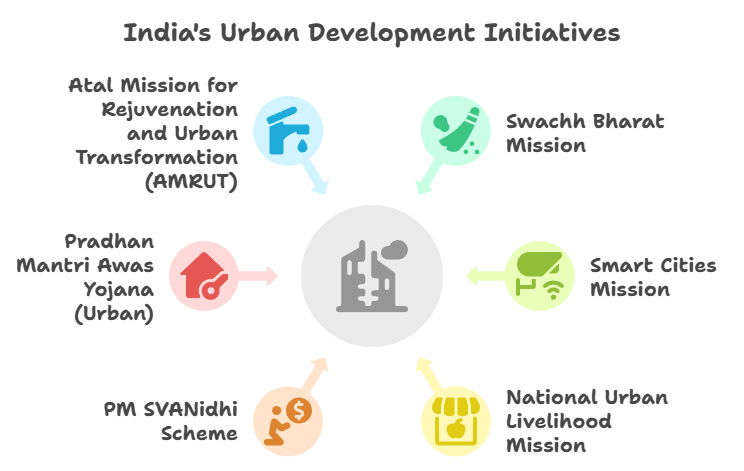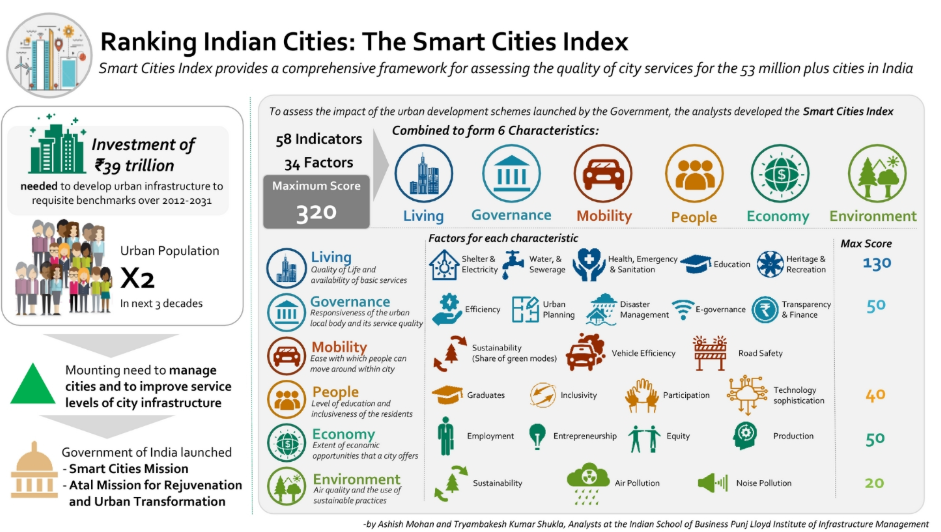Indian Society
Roadmap for Sustainable Urbanisation in India
- 29 Oct 2025
- 20 min read
This editorial is based on “ Urban planning in India is restricted to land-use planning. This needs to change”, which was published in The Indian Express on 29/10/2025. The article argues that India’s urban planning is outdated and overly focused on land-use regulation, urging a transformative shift towards an integrated economic vision, resource management, climate action, and regional planning to enable cities as engines of growth and sustainability.
For Prelims: Urbanisation, Smart Cities Mission, AMRUT Mission, National Urban Livelihoods Mission (NULM), PM2.5, Cyclone Fani (2019), Coalition for Disaster Resilient Infrastructure (CDRI), SDG 11
For Mains: Meaning and Major Trends of Urbanisation, Responsible Factors for the Rapid Pace of Urbanisation in India, Major Challenges Arising From the Rapid Pace of Urbanisation in India, Measures to Ensure Sustainable and Inclusive Urbanisation in India
India’s ambitious economic target of becoming a $30-trillion economy by 2047 requires urban planning reforms that go beyond traditional land-use regulation. With over 53% of the population projected to be urban by 2050, and cities contributing nearly two-thirds of GDP, current plans lack integration of economic visioning, resource budgeting, and climate action. Addressing infrastructure gaps, environmental challenges, and governance inefficiencies through comprehensive policy reform is critical for building resilient, inclusive, and growth-oriented urban centres.
What are the Current Major Trends Shaping Urbanisation?
- Definition: Urbanisation or “urban transition” refers to the process of population shift from dispersed rural settlements dominated by agriculture to concentrated urban centres characterised by industrial and service-based economic activities (UN, 2018).
- This results in a more urban society overall, which requires adaptation from both rural communities and urban dwellers.
- Urbanisation is the primary process through which cities form and grow.
- Global Trends: The world’s population has increased rapidly from 751 million in 1950 to an estimated 7.87 billion in 2021.
- According to the United Nations (UN), approximately 55% of people lived in urban areas as of 2018.
- This percentage is expected to grow to 68% by 2050, adding about 2.5 billion people to urban areas around the world. It is also projected that 90% of this increase will take place in Asia and Africa.
- Most of the world’s fastest-growing cities are in Asia and Africa. Between 2018 and 2050, the urban population of Africa is projected to triple and that of Asia to increase by 61 per cent, so that by 2050, most of the world’s urban population will be concentrated in Asia (52%) and Africa (21%) (UN, 2018)
- Trends in India: India’s urban population is expected to grow from 410 million in 2014 to 814 million by 2050.
- In India, as per the 2011 Census, 31% of people live in urban areas.
- By 2030, the number of cities with populations exceeding 1 million will grow from 42 to 68 (McKinsey, 2010).
- Four of India’s cities- Ahmedabad, Bangalore, Chennai, and Hyderabad — with currently 5 to 10 million inhabitants, are projected to become megacities in the coming years, for a total of seven megacities projected in the country by 2030 (UN DESA, 2014).
What Factors are Responsible for the Rapid Pace of Urbanisation in India?
- Population Growth & Migration: India’s overall population surged to approximately 1.46 billion by mid-2025, exerting immense pressure on urban areas.
- Driven by the search for better livelihoods, education, and healthcare, millions migrate from rural to urban areas each year.
- This migration led to Mumbai’s population crossing 22 million (2018) and Delhi exceeding 31 million.
- As per the “Migration in India, 2020–21” report based on the Periodic Labour Force Survey (PLFS) 2020–21, released by the Ministry of Statistics and Programme Implementation (MoSPI), the overall migration rate in India stood at 28.9%, with rural areas recording 26.5%.
- Among total migrants, about 10.8% reported migration due to employment-related reasons.
- Economic Opportunities and Industrialisation: Urban areas already contribute 63% to India's GDP (NITI Aayog, 2022), a share projected to exceed 75% by 2030 and 80% by 2050 (MoHUA, 2023).
- Urban centres provide diverse employment beyond agriculture, especially in services and manufacturing.
- Bengaluru’s rise as “India’s Silicon Valley” attracted over 1 million IT professionals.
- Urban jobs offer higher wages, with metropolitan per capita income often several times higher than rural areas, accelerating economic-driven urbanisation.
- Urban centres provide diverse employment beyond agriculture, especially in services and manufacturing.
- Improved Infrastructure & Basic Facilities : Development of metro rail networks in Delhi, Mumbai, Chennai, and Bengaluru has improved urban mobility and encouraged urban sprawl.
- Expanding national highways and digital infrastructure are linking urban hubs with smaller towns, fostering regional economic integration and urban expansion.
- Cities enjoy higher survival rates and better healthcare, leading to lower mortality and continued population rise.
- Environmental and Social Push Factors: Rural distress caused by environmental degradation and socio-economic challenges acts as a major push factor driving migration to cities.
- Frequent droughts, floods, and cyclones increasingly disrupt rural livelihoods.
- For instance, Cyclone Fani (2019) displaced thousands from Odisha’s coastal regions, forcing many into urban centres.
- Climate change, land fragmentation, and agricultural mechanisation further reduce rural employment, intensifying urban influx.
- Seasonal farming leads to irregular incomes, pushing workers toward urban areas in search of stable employment.
- Rural–urban income disparities and limited upward mobility push people toward cities.
- The rural workers are mainly engaged in low-paying agricultural or informal sector jobs, limiting livelihood opportunities and prompting migration.
- The Economic Survey 2024–25 states that there has been a significant increase in the share of women workers in the agriculture sector — rising from 57% in 2017–18 to 64.4% in 2023–24.
- During the same period, men’s participation in agriculture declined from 40.2% to 36.3%.
- The Economic Survey 2024–25 states that there has been a significant increase in the share of women workers in the agriculture sector — rising from 57% in 2017–18 to 64.4% in 2023–24.
- Frequent droughts, floods, and cyclones increasingly disrupt rural livelihoods.
- Government Policies and Urban Development Initiatives: The Smart Cities Mission aims to create 100 citizen-friendly, sustainable cities, while the Pradhan Mantri Awas Yojana (Urban) targets 2 crore affordable homes by 2025.
- AMRUT Mission improves basic urban infrastructure like water supply and sewerage in 500+ cities.
- National Urban Livelihoods Mission (NULM) enhances skill development and employment for the urban poor.
- Urban Transport initiatives promote sustainable public and non-motorised transport to reduce congestion and pollution.
- These policy initiatives enhance urban infrastructure, housing, and livability, thereby accelerating urbanisation.
What are the Major Challenges Arising From the Rapid Pace of Urbanisation in India?
- Infrastructure Overload: Indian cities are under immense pressure due to rapid population growth.
- By 2036, urban areas are projected to house 600 million residents, or 40 percent of the population, up from 31% urban population share in 2011, leading to strained roads, public transit, water supply, sanitation, and energy infrastructure.
- Cities like Delhi and Mumbai face severe congestion and overburdened transport systems, incurring annual costs of approximately $22 billion (Ministry of Road Transport and Highways).
- Traffic Congestion and Air Pollution: Traffic congestion costs India billions annually and contributes significantly to toxic air pollution.
- Delhi, Mumbai, and Kolkata rank among the most polluted cities globally, with PM2.5 levels exceeding WHO limits.
- For example, Delhi’s air pollution causes around 1.2 lakh premature deaths annually.
- National policy recommendations for prioritizing public transport and non-motorized travel often fail to translate into actionable mobility plans at the city level.
- Delhi, Mumbai, and Kolkata rank among the most polluted cities globally, with PM2.5 levels exceeding WHO limits.
- Housing Shortages and Water Scarcity: India faces a shortage of about 18.78 million housing units, predominantly impacting low-income populations, resulting in sprawling slums with inadequate sanitation, healthcare, and safety standards.
- Nearly 17% of urban households lived in slums as of 2011, with conditions deteriorating further as urban demand outpaces supply.
- Urban areas face severe water stress, with only 62% of households having access to piped water, and wastewater treatment capacity lagging at 30%.
- For instance, the Yamuna River in Delhi is critically polluted, rendering water unsafe for consumption.
- Environmental Degradation: Rapid urban growth causes loss of green spaces, wetlands, and water bodies.
- Fast urban sprawl increases waste generation, India generates approximately 62 million tonnes of waste annually, of which only about 75–80% is collected, and less than 30% is treated or recycled.
- This unchecked waste disposal and urban runoff have severely impacted water quality; according to the Polluted River Stretches Report published by the Central Pollution Control Board (CPCB) in November 2022, 311 polluted stretches have been identified across 279 rivers in 30 States and Union Territories of India.
- Flooding in Mumbai (2021) and Bengaluru (2024), along with rising urban heat islands, exemplify environmental vulnerabilities.
- Poor Urban Governance and Fragmented Planning: Institutional weaknesses, lack of coordinated planning, and outdated regulations inhibit sustainable urban development.
- Ineffective devolution of functions listed in the Twelfth Schedule under the 74th Constitutional Amendment has further weakened urban local governance, limiting the autonomy and accountability of Urban Local Bodies (ULBs).
- Indian city master plans primarily focus on land-use containment and population-based service allocation, with minimal emphasis on a long-term economic vision or transforming cities into “Economic Growth Hubs.”
- India has around 3,894 census towns with inadequate infrastructure due to slow recognition and planning.
- Urban India generates nearly two-thirds of the national GDP, yet its municipalities control less than 1% of the country’s tax revenue.
- Despite high needs, only a fraction of revenue is generated through property taxes, creating fiscal fragility due to reliance on central transfers.
- Urban master plans seldom cover economic linkages between urban and adjacent rural areas.
What Comprehensive Measures Can Be Adopted to Ensure Sustainable and Inclusive Urbanisation in India?
- Integrated and People-Centric Urban Planning: India needs to adopt integrated urban planning that harmonises spatial development with ecological sustainability and social inclusion.
- Odisha’s Rural-Urban Transition Policy is an example promoting sustainable rural-to-urban shifts with urban-grade infrastructure planning.
- Cities like Pune and Ahmedabad have pioneered in combining land use with economic growth, health, and climate resilience strategies.
- The Ministry of Housing and Urban Affairs advocates this approach for balanced regional development and resource optimisation.
- Countries like Singapore have successfully implemented integrated urban planning and smart infrastructure, serving as benchmarks for India’s need for comprehensive modernisation.
- Cities like Ghaziabad and Indore have successfully used green bonds to finance sewage treatment and solar projects, attracting private capital while promoting sustainability.
- Financing Urban Infrastructure through Innovative Mechanisms: Bridging the $6 trillion urban investment gap requires mobilising public-private partnerships (PPPs), municipal green bonds, and viability gap funding.
- Strengthening municipal finances through property tax reforms and creditworthiness assessments are key policy actions recommended.
- Cities like Seoul or Singapore have diversified revenue streams, including municipal bonds and public–private partnerships (PPPs), providing models for urban finance reforms in India.
- Affordable Housing and Inclusive Urban Regeneration: To address slum proliferation and housing shortages, schemes like Pradhan Mantri Awas Yojana (PMAY) target constructing over 1 crore affordable homes by 2025, integrating green infrastructure and mixed-use developments to prevent urban sprawl.
- Countries such as Brazil have combated this through participatory slum upgrading and affordable housing initiatives, providing lessons for India’s urban housing policies.
- Thailand’s Baan Mankong project demonstrates the potential of community-led slum upgrading through secure tenure and infrastructure improvements, fostering dignity and social equity.
- Promotion of Sustainable Mobility and Transit-Oriented Development (ToD): Cities like Pune and Surat showcase transit-oriented development (ToD) that emphasises pedestrian-friendly infrastructure and public transport over car dependency, reducing congestion and emissions.
- India’s PM-eBus Sewa promotes electric bus fleets, cutting urban pollution. Internationally, models from Copenhagen and Singapore illustrate integration of cycling-friendly lanes and efficient mass transit for greener mobility.
- Cities like Paris and London have adopted congestion charges and extensive public transport networks, illustrating effective demand management.
- Inclusive Safety and Social Equity Policies: Strengthening urban safety through community policing, legal enforcement, and gender-sensitive urban design combats rising urban crime.
- Inclusive policies integrating livelihood support, sanitation, and health enhance social cohesion.
- Holistic slum upgrading programs focus on empowering marginalized groups, ensuring equitable access to urban benefits.
- International experience, including participatory urban safety frameworks in Medellín, Colombia, offers replicable lessons.
Conclusion:
Sustainable and inclusive urbanisation in India is vital for achieving SDG 11, which seeks to make cities safe, resilient, and sustainable. As UN-Habitat expert Joan Clos observed, “Cities and towns have been, and continue to be, crucibles of innovation and advancement.” Thus, building India’s urban future requires integrated planning, affordable housing, climate resilience, and digital governance. Strengthening the fiscal autonomy of Urban Local Bodies (ULBs) and promoting participatory governance are essential for ensuring balanced growth aligned with the Sustainable Development Goals (SDGs), thereby fostering prosperous and equitable cities.
|
Drishti Mains Question: India’s rapid urbanisation presents both opportunities and complex challenges.Discuss the major challenges arising from this growth and their impact on urban governance and sustainability. |
Frequently Asked Questions (FAQs)
1. What is the projected trend of urbanisation in India by 2050?
India’s urban population is expected to grow from 410 million (2014) to 814 million (2050), with 53% of the population living in cities contributing nearly two-thirds of GDP.
2. Which government schemes are driving sustainable urbanisation in India?
Key initiatives include the Smart Cities Mission, AMRUT, PM Awas Yojana (Urban), NULM, and PM-eBus Sewa, focusing on infrastructure, housing, livelihoods, and sustainable mobility.
3. What are the major challenges posed by rapid urbanisation in India?
Challenges include infrastructure overload, housing shortages, traffic congestion, air pollution (PM2.5), water scarcity, fiscal constraints, and poor urban governance.
4. What measures are suggested for achieving sustainable and inclusive urbanisation?
Adopting integrated urban planning, affordable housing, green infrastructure, climate-resilient systems, and data-driven digital governance are key to sustainable cities.
5. How does sustainable urbanisation align with India’s global commitments?
It supports SDG 11 (Sustainable Cities and Communities) and global frameworks like the Coalition for Disaster Resilient Infrastructure (CDRI), promoting resilient, inclusive, and climate-adaptive urban growth.
UPSC Civil Services Examination Previous Year Question (PYQ)
Prelims
Q. As per the Solid Waste Management Rules, 2016 in India, which one of the following statements is correct? (2019)
(a) Waste generators have to segregate waste into five categories.
(b) The Rules are applicable to notified urban local bodies, notified towns and all industrial townships only
(c) The Rules provide for exact and elaborate criteria for the identification of sites for landfills and waste processing facilities.
(d) It is mandatory on the part of the waste generator that the waste generated in one district cannot be moved to another district.
Ans: (c)
Mains
Q. The frequency of urban floods due to high intensity rainfall is increasing over the years. Discussing the reasons for urban floods, highlight the mechanisms for preparedness to reduce the risk during such events. (2016)
Q. Do government schemes for up-lifting vulnerable and backward communities by protecting required social resources for them, lead to their exclusion in establishing businesses in urban economies? (2014)










